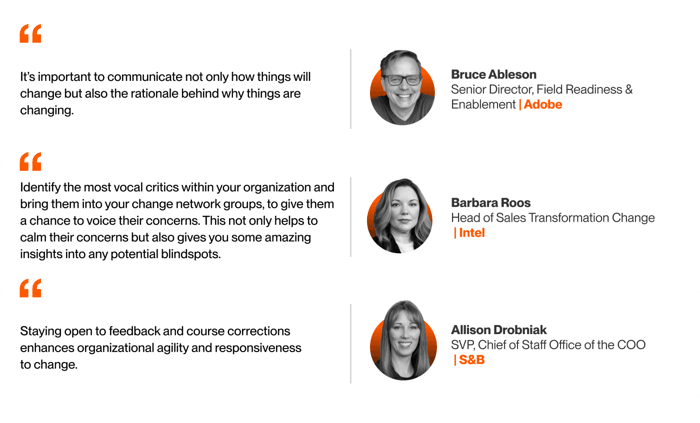The Executive Council for Leading Change (ECLC) organized a roundtable discussion focused on the critical topic of leading change during times of organizational restructuring. This executive brief provides an in-depth analysis and summary of the executives' conversation, shedding light on valuable insights, strategies, and challenges shared during the discussion.
This roundtable was held on April 24th, 2024.

4 Key Strategies for Leading Change Around Organizational Restructuring
Setting the Stage: As the company braces for significant changes such as organizational restructuring, it is imperative to provide as comprehensive an overview as possible of the impending transformation and its implications for the entire organization. This foundational understanding not only prepares employees for what lies ahead but also fosters a sense of transparency and trust, essential for navigating the uncertainties of change collaboratively.
Regular Updates and Communication
Executives highlighted the significance of consistent communication to manage expectations, build trust, and ensure alignment across all levels of the organization. The ability to communicate course corrections along the way also helps to keep everyone on the same page and moving in the same direction.
Opportunities for Open Dialogue
As the dynamics of organizational restructuring stir up a mix of emotions and uncertainties among employees, it is crucial to create spaces for open dialogue, where workers can express their feelings and concerns. Facilitating different kinds of feedback channels not only acknowledges the challenges that this kind of change brings but also fosters a workplace culture of empathy and understanding.
Investing in Employee Development
Prioritizing professional development and skill-building opportunities for employees demonstrates an organizational commitment to their individual growth and development, increases engagement, and enhances retention. Despite the uncertainty that organizational restructuring brings, employees often view ongoing training and development as a sign of stability and investment in their future within the organization & beyond.
4 Successful Approaches and Tactics for Leading Change Around Organizational Restructuring
AMAs and Fireside Chats
Executives emphasized the importance of transparent communication in managing expectations, building trust, and mitigating resistance to change. Through AMAs and fireside chats, employees can opt for meetings that suit their individual schedules and hear the change from another perspective, one that might resonate more with their unique stance.
Managing Expectations and Providing Gradual, Timely Updates
Setting clear expectations, providing regular updates, and managing timelines effectively helps minimize uncertainty and anxiety among employees during times of change. By also sharing information gradually, from one echelon of the company to the next, this gives senior executives and managers the time they need to digest information and prepare ways of supporting their teams through the change.
Meeting One-on-One with Influential People
Establishing one-on-one meetings with influential individuals within the organization can be instrumental in creating alignment around large-scale changes. These meetings provide an opportunity to address concerns, gather insights, and understand individual interests. By building personal connections and understanding individual perspectives, leaders can tailor their approach to effectively navigate potential challenges and garner pillars of support throughout the organization.
Get Ahead of the Rumor Mill
Recognizing the detrimental impact of rumors on morale and productivity during times of organizational restructuring, it is essential for leaders to proactively address and dispel misinformation. By leveraging transparent communication channels, executives can preemptively address concerns, clarify misconceptions, and provide accurate updates to employees. Additionally, by disseminating information gradually and consistently managing expectations, leaders can cultivate an environment of trust and openness, effectively mitigating the spread of rumors and fostering a more informed, resilient workforce.
2 Common Challenges Faced
Lack of Clarity in Roles and Responsibilities
During organizational restructuring, ambiguity surrounding roles and responsibilities can impede progress and foster uncertainty among employees. Without clear delineation of duties and expectations, individuals may experience confusion, leading to inefficiencies, wasted resources, and issues in credibility. Establishing transparent communication channels and providing comprehensive guidance on revised roles as well as responsibilities are essential steps in mitigating this challenge. Additionally, soliciting feedback from employees and actively addressing concerns can help clarify expectations and promote a smoother transition process.
Entrenched Corporate Cultures
Mature companies often exhibit entrenched corporate cultures resistant to change and uncertainty. Their workforce typically gravitates towards stability, structure, and established processes. Consequently, when implementing organizational restructuring, it becomes imperative to recognize the inherent risk aversion among employees. Addressing these concerns requires proactive measures that acknowledge and accommodate the preferences of the workforce for stability, while simultaneously fostering a culture that embraces necessary changes.
3 Notable Quotes from the Roundtable

Conclusion
The roundtable discussion underscored the critical role of employee involvement in driving successful organizational restructuring. By prioritizing clarity, communication, and ongoing support, organizations can navigate change effectively and achieve sustainable outcomes. This commitment to transparency and engagement not only fosters a culture of trust and collaboration but also empowers employees to actively contribute to the success of the restructuring process, ultimately enhancing organizational resilience and adaptability.
The Executive Council for Leading Change
The Executive Council for Leading Change (ECLC) is a global organization that brings executives together to redefine the landscape of organizational change and transformation. Our council's aim is to advance strategic leadership expertise in the realm of corporate change by connecting visionary leaders. It's a place where leaders responsible for significant change initiatives can collaborate, plan, and create practical solutions for intricate challenges in leading large organizations through major shifts.
In a world where change is constant, we recognize its crucial role in driving business success. ECLC’s mission is to create a community where leaders can excel in guiding their organizations through these dynamic times.
Interested in joining ECLC? Learn the membership criteria and sign-up below.
To download this executive brief, click here.

